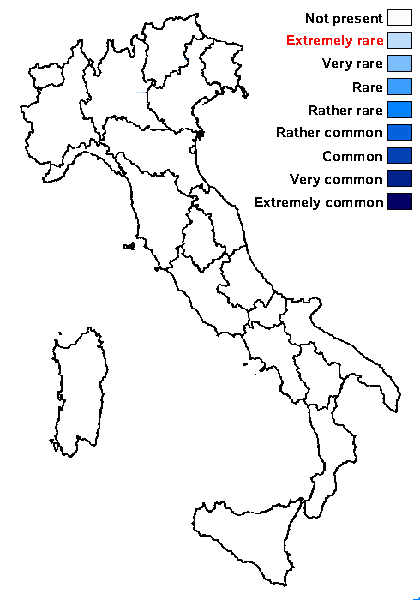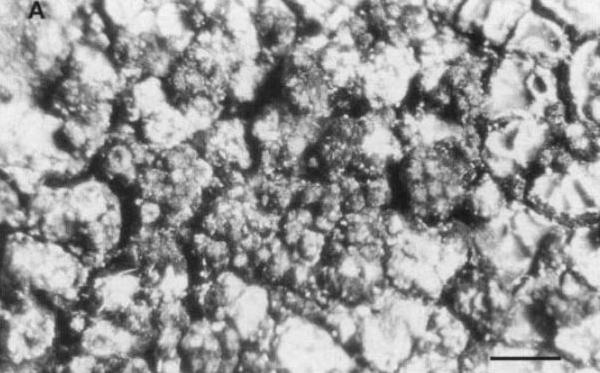Halecania giraltiae van den Boom & Etayo
Lichenologist, 33: 103, 2001.
Synonyms:
Distribution:
Description: Thallus, crustose, thinly episubstratic, areolate, forming scattered, irregular, up to 2 cm wide patches, the areoles angular, 0.2-1 mm wide, with a granular-warted surface, the granules 0.1-0.3 mm, brownish grey to blackish, matt, many areoles covered with round, convex, discrete to crowded, sometimes confluent, dark grey to dark brown or blackish, 0.1-0.25 mm wide soralia, the soredia farinose, c. 15-25 µm wide, covered by short-celled hyphae with dark brown caps (K-, N+ reddish). Cortex substituted by a brownish up to 10 µm thick epinecral layer. Apothecia rare, sessile to adnate, 0.2-0.6 mm across, lecanorine, with a flat to slightly convex, dark brown to black, epruinose disc and a smooth to granular, sometimes finally excluded thalline margin, the proper margin usually not evident. Thalline exciple up to 35 µm wide in upper part, the outer cells with a dark brown pigment and interspersed with irregular, c. 5-15 µm wide crystals not dissolving in K; epithecium medium to dark brown, K-, N+ faintly reddish brown; hymenium colourless, 50-75 µm high; paraphyses coherent, simple or sparingly branched, 1-5-2 µm thick at mid-level, the apical cells swollen 3.5-5 µm wide, mostly with an internal dark reddish brown pigment. Asci 8-spored, narrowly clavate, with a blue outer coat and uniformly K/I+ blue apical dome, Catillaria-type. Ascospores 1-septate with slightly unequal cells, hyaline, ellipsoid, thin-walled, 9-12 x 5.5- 6.5 µm (excluding perispore), surrounded by a perispore which markedly swells in K, c. 2 um thick. Pycnidia immersed, c. 40-80 µm in diam., the wall colourless except in the brown part near the ostiole, the conidiogenous cells enteroblastic. Conidia simple, hyaline, ellipsoid to bacilliform, 3-5 x c. 1 µm. Photobiont chlorococcoid. Spot tests: thallus and soralia K-, C-, KC-, P+ orange-red, UV-. Chemistry: argopsin (major) and norargopsin (minor).Note: this sorediate, often sterile and hence easily overlooked species was described from the Iberian Peninsula, where it occurs both in the Atlantic region and in central areas of Spain with a drier, Mediterranean climate. It grows on siliceous rocks, usually on N-facing surfaces, and starts the life-cycle on several other crustose lichens. To be looked for in Italy, especially in Sardinia.
Growth form: Crustose
Substrata: rocks
Photobiont: green algae other than Trentepohlia
Reproductive strategy: mainly asexual, by soredia, or soredia-like structures (e.g. blastidia)
paras crustose lichens

Predictive model
Growth form: Crustose
Substrata: rocks
Photobiont: green algae other than Trentepohlia
Reproductive strategy: mainly asexual, by soredia, or soredia-like structures (e.g. blastidia)
paras crustose lichens

Predictive model


